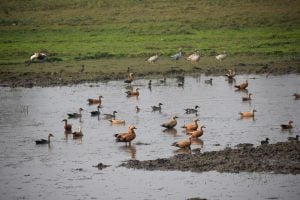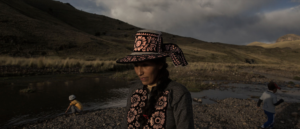One of the most fertile valleys in the Himalayas provides a bumper harvest of mustard, wheat, vegetables and millet thanks to the traditional irrigation channels that bring the water of the Gagas River to the farms in this part of Kumaon in the northern Indian state of Uttarakhand.
“The River Gagas is our main source of drinking water and irrigation,” says 27-year-old Bhupendra Singh Bisht, a resident of Rawalsera village in the valley. Canals (from the river) bring water to the fields and make this (agriculture) possible for us.”
Gagas is one of the myriad spring-fed rivers without which life would be almost impossible in the Himalayas. While large glacier-fed rivers such as the Ganga, Brahmaputra or Indus get all the attention, the relatively small spring-fed rivers in the middle Himalayas are what sustain the local people.
The big rivers form gorges so deep that it is difficult to fetch water from them for everyday use. In most places, those gorges are too steep to farm on the riverbanks.
In contrast, the spring-fed rivers start in the forests at the top of local hills, flow through relatively wider valleys and finally meet the larger glacier-fed rivers. They provide a crucial source of water in the winter when there is very little flow from the frozen glaciers. A maze of irrigation channels (locally called gul) take the water from the rivers to the fields and return the water downstream after irrigation.
“The entire gul system developed in Uttarakhand and Himachal Pradesh is fed by these non-glacial rivers,” says Yogesh Gokhale, a senior fellow, at the forestry and biodiversity division of the New Delhi-based think tank, The Energy and Resources Institute (TERI).
![Bhupendra Singh Bisht shows a water channel (gul) that flows from the Gagas river and irrigates farms in the valley [image by: Hridayesh Joshi]](https://dialogue.earth/content/uploads/2019/02/Springs2.jpg)
Forest rivers
In the Himalayas, there are many non-glacial rivers such as the Gagas. locally called “forest rivers”, because that is where they originate. Together, they form an intricate web that is the backbone of perennial water supply in the Ganga basin.
“In 1992 when the first (Earth) Summit was organised in Rio de Janeiro, the Himalayan glaciers were termed water towers of the 21st century. I have been saying since then that though glaciers are definitely water towers, the forests are too,” says the doyen of environmental historians Shekhar Pathak.
“In fact, they are double water towers because they not only preserve and maintain water in the ground, but also release water when in winters the glaciers don’t melt, and the snowy rivers don’t give you water. For three to four months t these non-glacial rivers continue to supply water to these perennial rivers.”
Critical for the survival of local communities, these rivers also have religious, mythological and historical importance as well. Gomti and Garudganga meet at the temple town of Baijnath, which was the capital of the Katyuri kings, the medieval ruling clan, between 800 and 1100 CE.
![Ramganga, one of the largest forest rivers in Uttarakhand [image by: Hridayesh Joshi]](https://dialogue.earth/content/uploads/2019/02/Springs3.jpg)
Watershed destruction
Today, all these rivers are in danger. The main threat is deforestation. Ill-planned road construction, house construction and hydropower dams have led to trees being cut down. Add to that encroachment on forests for agriculture, horticulture and pasture. In Uttarakhand, over 45,000 hectares of forest land have been diverted to other use since 1980. Trees in over 60% of these areas have been felled since 2000.
The recently released Hindu Kush Himalayan Monitoring and Assessment Programme, by the Kathmandu-based International Centre for Integrated Mountain Development, stated, “Springs have been particularly affected by the depletion of shallow water table because of reduced infiltration due to crust formation and by increased intensity of rainfall. They are further impacted by rapid socio-economic growth, demographic changes, and infrastructural developments, such as dams and road building.”
It added, ominously, “Due to scarce observation data, the status of most springs in this region is still unknown.”The low regard for gathering such data indicates the lack of policy interest in this critical resource.
The pressure of population has increased rapidly on hill towns of Uttarakhand. India’s census shows that urban population of the state has doubled in the last two decades. The population in urban areas has jumped from 1.63 million (23%) in 2001 to 3.09 million (31%) in 2011.
![A view of Pithoragarh [image by: Vipin Gupta]](https://dialogue.earth/content/uploads/2019/02/springs4.jpg)
This migration has resulted in rapid construction for housing and business. Forests have been cut to make space for buildings, including for hotels and resorts to boost tourism. All this has taken place in the absence of any planning and ignoring any laws and regulations. River catchments are being destroyed and the hydrology of the region has been disturbed.
“We have seen hill towns like Almora growing as much as five times in the last fifty years. All the construction is done over the places where there used to be wells. This has affected the catchment,” says G.C.S. Negi, a scientist with the G.B. Pant National Institute of Himalayan Environment and Sustainable Development in Almora.
Environmental norms and laws are frequently violated during road construction across the mountains. Trees are cut without any clearance from the forest department and debris thrown into the rivers below. The process has significantly increased the number of landslides in the region.
![River Gomti meets another important non-glacial river Garudganga in the historic town of Baijnath in Uttarakhand [image by: Hridayesh Joshi]](https://dialogue.earth/content/uploads/2019/02/springs5.jpg)
Depleting groundwater
The cutting down of forests affects percolation of water underground, drying up the water channels (known as nallas and gadheras in Kumaon) that feed the non-glacial rivers. Local resident Ram Singh Bhandari explained the main reasons for the drying up. “The rainfall isn’t as much as it used to be 25 years back. Another reason is the method adopted for the drinking water supply schemes by (government) departments. They have dug borewells and extracted all the groundwater.”
![Such water channels were once alive and fed non-glacial rivers [image by: Hridayesh Joshi]](https://dialogue.earth/content/uploads/2019/02/Springs6.jpg)
“The correct way to provide water is make supply line from the rivers (to the villages) but the authorities have found it easier to dig borewells says Tiwari pointing to the famous Dosad ka Gadhera (a water channel) in Bagwalipokhar which is dry now. “There was a time some 25 years ago when this Dosad ka Gadhera had so much water we couldn’t cross it. But you can see what is left now.
This article was first published by indiaclimatedialogue.net.



![A view of receding flood waters in Srinagar city during the September 2014 flooding. [image: Athar Parvaiz]](https://dialogue.earth/content/uploads/2017/11/A-view-of-receding-flood-waters-in-Srinagar-city-during-the-September-2014-flooding-Credit-Athar-Parvaiz-e1509633052651-300x225.jpg)



![Women in Kapri village Bajura, western Nepal, preparing millet for use after harvest [Image by Nabin Baral]](https://dialogue.earth/content/uploads/2019/01/photos-for-story-two-1-300x200.jpg)